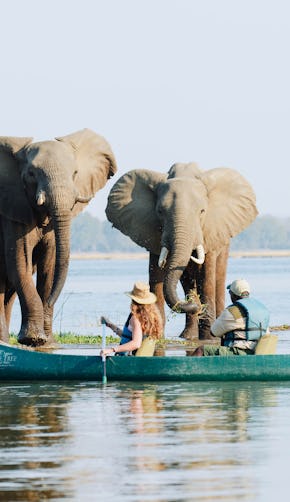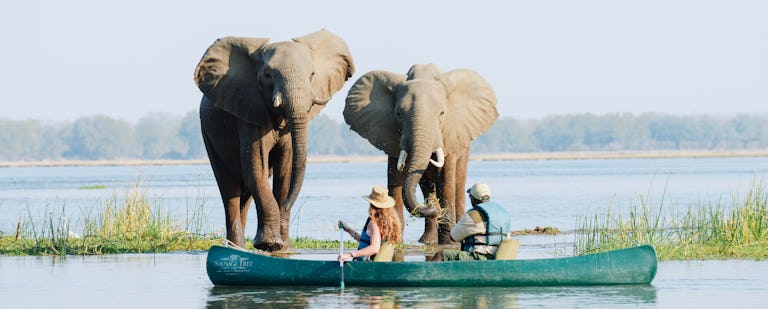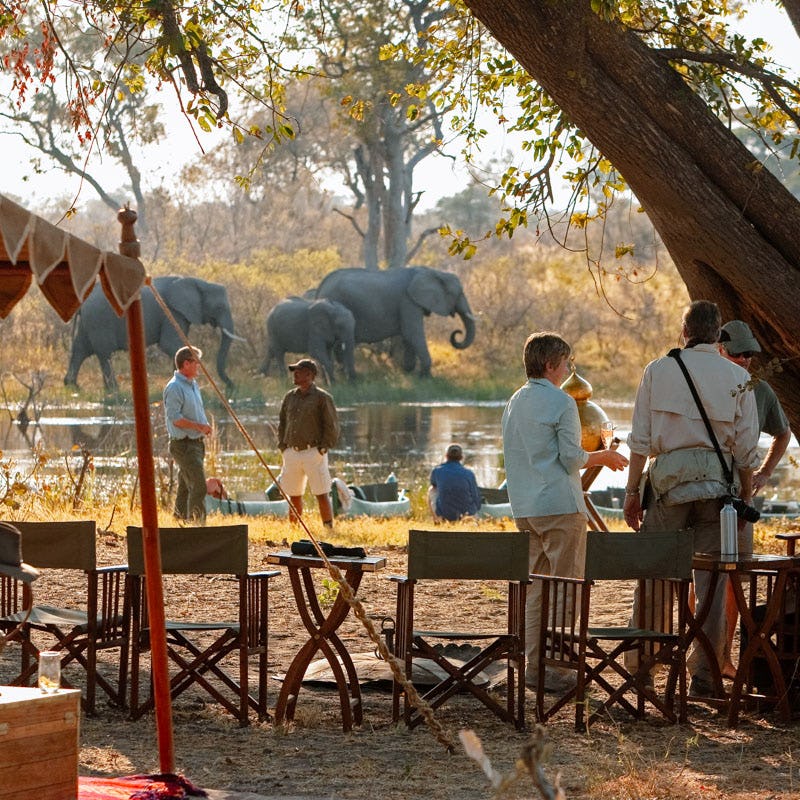The gentle giants of the ocean, whales are integral ‘ecosystem engineers’ who help keep the sea healthy in a variety of ways. Seeing these majestic creatures in their natural habitat is truly magical and the waters off the coast of South Africa just happen to be one of the best places to do so. From west to east, on land or by sea, a variety of whale species can be spotted. Read on for our guide on where to go whale watching in South Africa.
The best time to go whale watching in South Africa
Between June and November each year, southern right whales leave behind the icy waters of the Antarctic to breed and calve in the warm waters off the coast of Mozambique and Madagascar. A host of other species also follow this route along the Mozambique Plateau, which is essentially a whale highway. The most prominent species to look out for include southern right, humpback and Bryde’s whales, which each have their own distinctive features.
The whale migration also coincides with a portion of the famous Sardine Run (May to August), where billions of sardines spawn in the cool, nutrient-rich waters of the Agulhas Banks before heading north in search of warmer waters. These tiny fish are followed by super-pods of whales and dolphins, as well as sharks and flocks of diving birds.
How to go whale watching in South Africa
In most of the destinations we’ll cover in this blog, land-based whale watching is possible with a good pair of binoculars and a high vantage point from which to enjoy the view of whales spouting, splashing and even jumping out of the water.
For a more up-close and personal experience, take a chartered boat ride into the open ocean accompanied by an expert skipper and guide. Typically, whales are quite curious around humans and may even surface within a metre or two of the boat. Your guide will be able to share insightful information about the different species you encounter, explaining their behaviour and movements, as well as any other marine life you come across.

Where to go whale watching in South Africa
The whales’ migratory route takes them up the coast of South Africa where they pass through several Marine Protected Areas including Table Mountain National Park, De Hoop Nature Reserve and iSimangaliso Wetland Park. Along the coast, there are a number of specific spots that promise fantastic whale watching.
False Bay
An entire mountain and national park only a short distance from Cape Town, the serene False Bay is so named because it often confused mariners on their way to the more famous Table Bay. Putter out from Simon’s Town on a whale watching cruise and spot humpback, southern right and Bryde’s whales, your skipper calling out information about their movements. Boulders Beach is also famous for its colony of tiny African penguins, while False Bay is home to colonies of Cape fur seals.
Where to stay?
You couldn’t be closer to the waters of Boulders Beach at this stylish yet homely villa with sensational ocean views and service that’s second to none.
Hermanus
Just under two hours away from Cape Town, Hermanus is a darling right at the start of the Garden Route where the striking coastal scenery is flanked by mountains and forested trails. It also happens to be one of the best places for land-based whale watching in the world.
Why? The waters are extremely deep right up to the shoreline making it possible for whales to swim incredibly close, where they can be spotted from clifftop paths, rocky outcrops and even the beach. Walking along the well-loved 12km-long clifftop trail, you’ll have the chance to spy migrating southern right whales and resident Bryde’s whales, as well as dolphins and sea lions. There are also boat tours available for the more intrepid who long to feel the spray of a spouting whale beside the vessel.
Hermanus is also well-known for its Whale Festival, which happens every year between September and October, where you can enjoy hearing the Whale Crier announcing their arrival in the bay, as well as interesting exhibitions and seriously good food.
A little way along the coast from Hermanus, Gansbaai is a fantastic location for boat-based whale watching, where there have been sightings of southern right and humpback whales, and even orcas (although, they’re officially part of the dolphin family).
Where to stay?
A beloved property on the crags of Hermanus with direct access to the iconic clifftop path and fabulous views over the inviting Walker Bay (a hive of activity in calving season). We’d opt for an ocean-facing room for the best views.

Overberg
Around a two-hour drive from Hermanus, this region extends through the Cape Agulhas, the southernmost tip of Africa where the Indian and Atlantic oceans meet. This is a huge drawcard for migrating whales and the coastal waters have been declared a Whale Sanctuary Marine Protected Area. In the vicinity, De Hoop Nature Reserve has staggering views, which can be enjoyed as you explore its many hiking trails or the iconic dunes, eyes peeled for whales splashing about in the bay.
Where to stay?
Lekkerwater Beach Lodge at De Hoop
The scenery is impeccable, the wild surroundings are virtually untouched and the whale watching is out of this world – even from your own deck.
Knysna
Laidback, chilled-out vibes await at this coastal town. Enjoy walkabouts in the beautiful forested surrounds, cool down in the shimmering lagoon or, for the really adventurous, embark on a sail through the famous ‘Heads’ and out to sea. Take advantage of one of the many boat tours to set off in search of southern right and humpback whales, or pods of bottlenose dolphins. And, if the mood takes you, enjoy a lunch of oysters and champagne on board.
Where to stay?
An intimate boutique hotel with fabulous interiors to match the vistas of fynbos-covered wilderness and ocean stretching out towards the horizon.
Plettenberg Bay
The waters off South Africa’s famous Garden Route are a hotspot for humpback and southern right whales as they make their way north from May and south again around October or November. With its pristine, white-sand beaches and fynbos-enveloped hills, Plettenberg Bay is one of the best places for whale watching in South Africa. In this part of the country, you can spy the incredible creatures from land, or by boat, kayak or helicopter. Resident species like Bryde’s whales can be seen year-round, alongside bottlenose and humpback dolphins.
Where to stay?
Sitting pretty on a peninsula facing Lookout Beach, Milkwood Manor on Sea captures the warmth and charm of Plettenberg Bay and acts as a fantastic springboard for all the activities on offer.

Eastern Cape & Wild Coast
On their migratory route, the whales continue to trace the coast and from the rugged beaches of the Eastern Cape, humpback and southern right whales are common sights from the shore along with otters and dolphins. Forming a portion of the Eastern Cape, South Africa’s Wild Coast is one of the most spectacular regions in the country with a rocky coastline, indigenous forests and wide river mouths. The migrating whales don’t tend to come as close to the coast as they do in other areas so it’s best to find a high vantage point as you hike one of the many trails.
Where to stay?
Along a beautiful stretch of coastline, the Prana Lodge is your answer to wellness in the wilderness with huge suites, private plunge pools, and an all-encompassing spa.
Elephant Coast
While South Africa’s west coast gets a lot of hype when it comes to whale-watching, the coast of KwaZulu-Natal easily boasts the highest number of whale sightings each year. The whales’ migration route passes close enough to the shores of the Elephant Coast that they can be spotted from land, but a boat trip is definitely worth it for up close and personal sightings. This is especially true in the iSimangaliso Wetlands Park, a UNESCO World Heritage Site where an astonishing variety of whales have been recorded. Some special sightings include minke and pygmy killer whales, as well as orcas.
Where to stay?
A little slice of magic where you’re never far from the lapping Indian Ocean and the snorkelling is on another level.

Whale Conservation
Whales are considered to be one of the biggest conservation success stories of the last 50 years with several species coming back from the brink of extinction. While whaling has been outlawed, other, human-caused threats still linger and their conservation is as important as ever. In general, whale watching helps raise awareness for the vital role whales play in our marine ecosystem as well as the importance of protecting their ocean home. There are a plethora of fantastic organisations to get involved with if you feel inspired to, and we can always point you in the right direction.
How likely are you to see a whale?
Even during peak season, there is no guarantee that you will see whales. If you do encounter a whale, their behaviour is a big factor in what kind of time you spend with them. A reputable operator will always minimise the level of disturbance to the animals and their wellbeing is always the highest priority. However, skippers who have been studying whales for years know where to look for whales and how to behave around them, offering the best chance for an amazing sighting.
A few tips for your whale watching trip
Boat-based whale watching is heavily weather dependent so it’s important not to book your tour for your last day at a destination in case it should be postponed. If you’re travelling as a family with little ones, it’s important to note that most boat trips have an age restriction, most commonly 12 years of age. It can get chilly out on the water so come prepared with warm, waterproof clothing that will fit under a life jacket, even if it’s warm on the shore. And, should you need them, sea sickness tablets!
Whale watching lingo
When you’re on the water, your eyes peeled for any sign of a whale, your guide or skipper may call out a phrase you’ve never heard before. So, it helps to be prepared by knowing some of the terminology associated with whale watching.
Breaching: Rising and breaking through the surface of the water, sometimes leaving the water entirely. This is done for a number of reasons including communication, competing for females and the removal of dead skin or parasites.
Blowing / spouting: Exhaling air at the surface of the water through their blowhole accompanied by a spout of water vapour, which is part of their normal breathing pattern.
Lobtailing: Lifting the tail vertically above the water before slapping it back down. This may be done to communicate with other whales or stun fish.
Spyhopping: Lifting their head above the water to flipper-level in order to have a look around.
Logging: Lying in the water with their back and head above the surface, and the tail submerged.
Whether you prefer to remain on dry land with binoculars glued to your eyes or sail across the great blue to spy these magnificent beasts up-close, seeing a whale never fails to thrill. If you’re looking for other memorable things to do in South Africa, take a look at our blog.


















